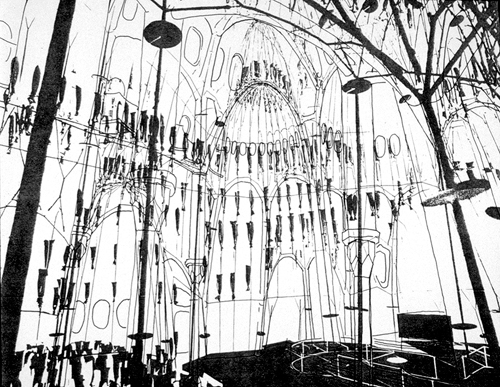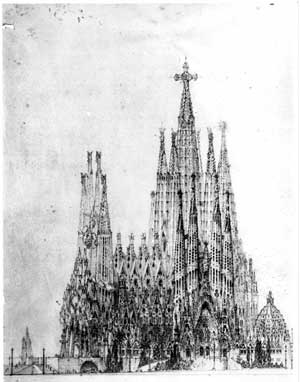An End in Sight for a Centuries-Old Building Project?
Among the technological advances is a "file-to-factory" construction system. Since the usual trinity of plan, section, and elevation was not sufficient to translate GaudÃ's unusual forms to the stone masons who would create the building elements by hand, intricate scale models were needed to illustrate the components' irregular structure and fanciful shapes. Today, complex computer drawings feed information to a stone-cutting machine and other fabricators, thus eliminating one of the most time-consuming aspects of the building's earlier construction.
But the surviving pieces of those early models proved invaluable for determining-beyond a doubt, in the opinion of some-GaudÃ's audacious design. "If the Casa Milà had been left half-built and the models partially destroyed, there would be no hope whatsoever to restore it according to GaudÃ's wishes because it was a free-form building," says Mark Burry, referring to GaudÃ's famous apartment complex in Barcelona's Eixample district, begun in 1905. Burry, a professor at the Royal Melbourne Institute of Technology (RMIT), in Australia, has written and lectured extensively on the Sagrada FamÃlia. His involvement with the project began 30 years ago, when in a student thesis project he himself questioned the contemporary builders' authority to continue construction.
 |
|
 |
Gaudà used
hanging models Drawings: Jos Tomlow (top); |
 |
|
Â
According to Burry, Gaudà began to use a codex of very rich geometries in his last years. Some model fragments contain important information, like the intersection of three surfaces, or triple points. Enough of these triple points exist, along with photographic documentation of lost models, to provide strong evidence for the final design. "Gaudà came up with a language which allows us to readily assimilate the role of his successors," Burry explains. "If he hadn't used this language, we would have been inventing for ourselves, and the criticism that the building gets from time to time would be valid. But what has been built after his death has come directly from this evidence, so there's no question of its being somebody else's interpretation of what Gaudà would have done."
Up until the early 1980s, architectural work at the Sagrada FamÃlia was overseen by former collaborators of GaudÃ's, who were well past retirement age by then. The current head architect, Jordi Bonet, was also privy to firsthand accounts of GaudÃ's design process from his father, LluÃs, another collaborator. But Bonet says that kind of intimate knowledge of the project is not necessary to continue with construction in the future. "Gaudà knew it would be impossible to finish the church within his lifetime," Bonet explains. "So he developed a new architecture that was different from his previous work. It is a synthesis of form and structure based on geometry. And because geometry is an exact science, we can build it today precisely the way Gaudà pictured it in his head."









